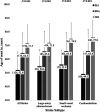Ischaemic stroke in South Asians: The BRAINS study
- PMID: 36260058
- PMCID: PMC10098949
- DOI: 10.1111/ene.15605
Ischaemic stroke in South Asians: The BRAINS study
Abstract
Background and purpose: Studies on stroke in South Asian populations are sparse. The aim of this study was to compare differences in age of onset of ischaemic stroke in South Asian patients living in the United Kingdom and South Asian patients living in India versus White British stroke patients.
Methods: We studied the UK and Indian arms of the ongoing BRAINS study, an international prospective hospital-based study of South Asian stroke patients. The BRAINS study includes 4038 South Asian and White British patients with first-ever ischaemic stroke, recruited from sites in the United Kingdom and India.
Results: Of the included patients, 1126 were South Asians living in India (ISA), while 1176 were British South Asian (BSA) and 1736 were White British (WB) UK residents. Patients in the ISA and BSA groups experienced stroke 19.5 years and 7.2 years earlier than their WB counterparts, respectively (mean [interquartile range] age: BSA 64.3 [22] years vs. ISA 52.0 [18] years vs. WB 71.5 [19] years; p < 0.001). Patients in the BSA group had higher rates of hypertension, diabetes mellitus and hypercholesterolaemia than those in the ISA and WB groups. After adjustment for traditional stroke risk factors, an earlier age of stroke onset of 18.9 years (p < 0.001) and 8.9 years (p < 0.001) was still observed in the ISA and BSA groups, respectively. In multivariable stepwise linear regression analysis, ethnicity accounted for 24.7% of the variance in early age onset.
Conclusion: Patients in the BSA and ISA groups experienced ischaemic stroke approximately 9 and 19 years earlier, respectively, than their WB counterparts. Ethnicity is an independent predictor of early age of stroke onset. Our study has considerable implications for public health policymakers in countries with sizable South Asian populations.
Keywords: age onset; ethnicity; health inequality; stroke.
© 2022 The Authors. European Journal of Neurology published by John Wiley & Sons Ltd on behalf of European Academy of Neurology.
Conflict of interest statement
The authors declare that there is no conflict of interest that could be perceived as prejudicing the impartiality of the research reported.
Figures

References
-
- Office for National Statistics . 2011 Census: Ethnic Group, Local Authorities in the United Kingdom; 2013.
Publication types
MeSH terms
LinkOut - more resources
Full Text Sources
Medical

